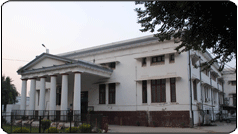Tare wali Kothi - Royal Observatory
Eccentricities, whims and fancies of persons in power often result in strange consequences, gainful sometimes, and quite often, in loss. Both the British as well as the rulers of Awadh were no exception.
Wajid Ali Shah, the fifth and last King of Awadh, on January 20, 1849, ordered the closure of the Royal Astronomical Observatory [Shahi Rasad Khana] which was built at the initiative of Naseer-'ud-Din Haider, the second King. The order came just because Kamal-ud-Din Haider, a translator employed in the Observatory, had shown him in bad light in his book titled Sawanah-e-Salaatin-e-Awadh, depicting the lives of the rulers of Awadh.
He had mentioned the wearing of English pater': leather shoes by the King while receiving the Governor General, Lord Dalhousie, in November 1847 at Kanpu. [at the latter's encampment on the banks of the river Ganga] because Indian shoes had been prohibited for the occasion.
Strangely, Wajid Ali Shah had spent four and a half lakh rupees on the improvement and repair of this Observatory, out of which just fifty thousand nad been spent on procurement of stone from Mirzapur.
The King had also provided an annual grant of over six thousand rupees for the upkeep of the Observatory which was popularly known as Tare wali Kothi. [Tare are stars and therefore the mansion for observation of stars came to be called Tare wali Kothi].
In 1831 King Naseer-ud-Din Haider proposed to establish the Royal Observatory and mentioned its being 'not only as a means of establishing a series of observations of heavenly bodies, but more particularly as a school for young courtiers in which some knowledge of astronomy and general physics might be taught'. These sentiments of the King are recorded in the diary of Captain James Herbert, who was later appointed as astronomer and superintendent for the construction of the Observatory on the recommendation of the Governor General at Calcutta. Raja Bakhtawar Singh was made supervisor of the construction work which began in 1832.
In February 1835, King Naseer-ud-Din Haider appeared dissatisfied with the progress and requested the Governor General for sending another astronomer and Captain Herbert was replaced by Lieutenant Colonel R.Wilcox.
Naseer-ud-Din Haider died in the night of July 7-8, 1837 while the project was incomplete and his uncle, Mohammed AM, whom the British appointed as the new King, was initialy not willing to proceed with the project, saying that he could not afford it. The project was however, completed in his reign, at the end of 1841, with more than 19 lakh having been spent on the building and setting up of the Observatory.
Built on a raised ground, Tare wali Kothi was a two storeyed building with two large halls in the centre with basements. A small circular room for observation was built on the top which was provided with a metalic hemispherical dome, that could be rotated to any desired position with the help of a wheel and pulley system. The dome had movable shutters that could be manipulated to open or cover the opening, as desired, for observation of the stars and planets.
The Observatory was designed on the pattern of the Greenwich Observatory in England and had instruments similar to those installed there. It had four telescopes besides barometers, magnetometers, lodestones, thermometers and static electricity galvanic devices. The main telescope was mounted on a 20 metre high pillar, which had the foundation on the ground floor.
Besides Wilcox as the Astronomer General, names of Kali Charan and Ganga Prasad appear in records as his assistants. Rasik Mohan from Bengal, was incharge of the chronometer.
The Observatory is credited with the publication of the Lucknow Almanac and the translation of English books and journals connected with astronomy, published from Calcutta. [These translations were published at the Shahi Chhapa khana, the Royal printing Press which had been established at Lucknow in 1819].
Tare wali Kothi also figures in the freedom struggle of 1857-1858 rince it served as a temporary assembly of Maulvi Ahmad-ullah Shah who was one of the chief leaders of masses in rebellion against the British.
According to historical accounts, it was this Kothi where the Raja and Taluqedar of Awadh assembled on November 2, 1857 and signed a declaration to wage war against the British and fight till the end in support of Begum Hazrat Mahal and Prince Birjis Qadr, who had been made the Wali (guardian) of the kingdom in absence of the King, Wajid Ali Shah, interned at Calcutta by the British after the illegal annexation of Awadh in February 1856.
Tare wali Kothi, the Royal Observatory suffered extensive damage in the conflict during March 1858 when Lucknow was re-occupied by the British forces.
Today Tare wali Kothi is in use by the State Bank of India (S.B.I.) as part of its head office near the Babu stadium.
Source:
Hindustan Times, City Scan, A Time in History
Wednesday 17.9.1997 — Tare wali Kothi: Victim of a royal prejudice

